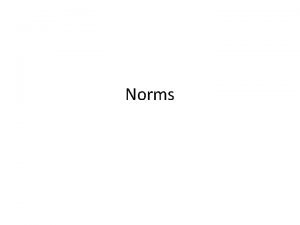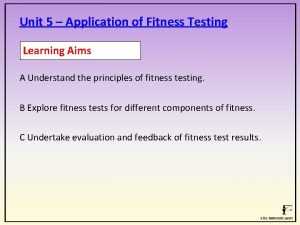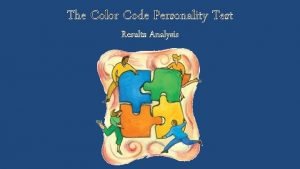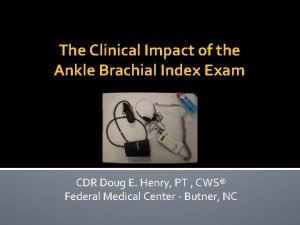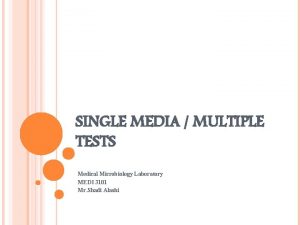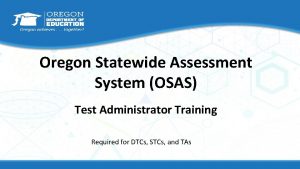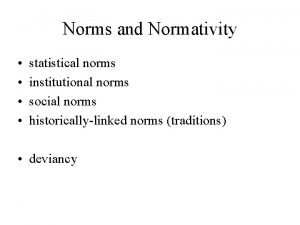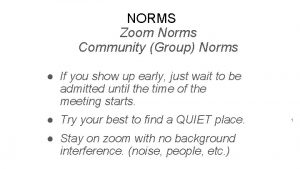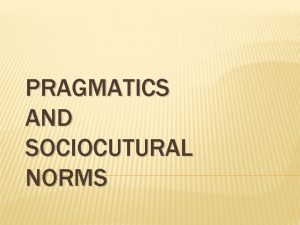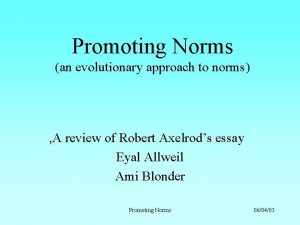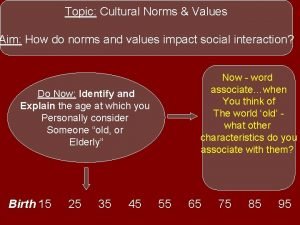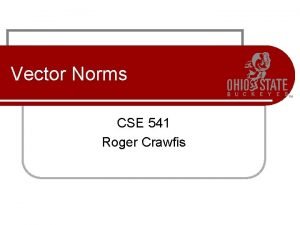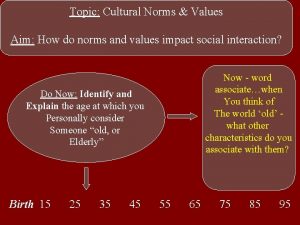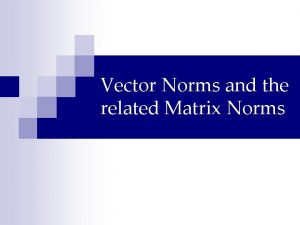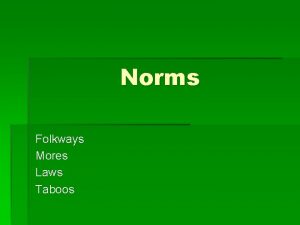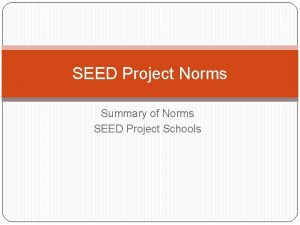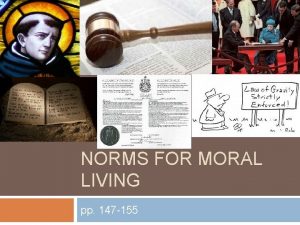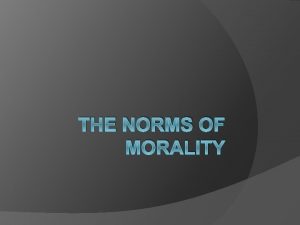Norms Interpreting test results If we assume that
























- Slides: 24

Norms

Interpreting test results If we assume that • Test is properly constructed • Test is reliable • Test is valid How can we make our interpretation / inference?

Raw Score number (X) captures some aspect of a person’s performance • how fast task were solved (e. g. sum of seconds spend on each task) • how many task were solved (e. g. no task solved properly) • how well task were solved (e. g. • how many mistakes were made – (e. g. no errors) • how severe are symptoms – (e. g. no of symptoms) How can we give meaning to the X? and interpret some number? For instance X = 20?

Frames of reference Norm-referenced test - standards based on the performance of specific groups of people to provide information for interpreting scores. useful for comparing individuals 1 vs 1 or 1 vs Group Most widely used frame of reference

Frames of reference Norms • refer to the typical behavior of one or more reference groups • presented in the form of set of statistics summarizing performance of the group (normative or standardization samples)

Frames of reference Criterion referenced test – standards based on test performance criteria, e. g. cutt-off point. • relationship between test and standard is demonstrable and well defined • designed to assess whether and to what extent the desired levels of mastery or performance criteria have been met.

Norms Within group norms • Group or groups are point of reference – Placing test taker performance within normative distribution • Composition of normative sample (key issue) • Two main types based on – Uniform distribution – Normal distribution

Normative sample • Representative for the population (individuals that test is intended to) • Size – large = stability (usually ‘ 1000 +’) – Construct characteristics and amount of important factors • Demographic (gender, age…) • Purpose of the test – Special samples NOTICE: Some vocabulary problems Standardization sample: original sample for standardization and normalization Normative sample: synonymous to previous but used also for any subsequent samples used for obtaining norms Reference group: loose term -> any group used for score comparison

Normative sample • Reference groups – wide (nation wide representative) or specialized (clinical or occupational group) • Subgroup norms (usually by gender or age) – sufficient size – representative of their categories • Local norms – Based on local (e. g. geographical or organizational) groups • Convenience norms – convenient but not very useful

Assessing quality and Applicability of a Normative Sample How large is the normative sample? When was the sample gathered? Where was the sample gathered? How were individuals identified and selected for the sample? • Who tested the sample? • How did the examiner or examiners qualify to do the testing? • What was the composition of the normative sample (age, sex, ethnicity, race, linguistic background, education, SES, geographic distribution, ANY OTHER RELEVANT VARIABLE) • •

Norms – Percentiles • represent the percentage of persons in the reference group who scored at or below a given raw score • Percentile not to be confused with percent • most direct method • MAIN advantage – readily understood by test takers and applicable to most sorts of tests and test populations.

Transforming results • Ordering results in the normative sample from lowest thru highest

Percentiles • Transformation => Uniform (rectangular)distribution, is a distribution that has constant probability • No of units = 101 percentiles • Range = 0 – 100. • Median = 50 • Each pecentile is equivalent to 1% of observations exept 0 & 100 = 0, 5% Disadvantage = unequal units


Norms – Normal distribution. Standard Scores • Transforming raw scores into standard score Continuous variable M = 0 and SD = 1 Range = unlimited No of units = unlimited (unit as small as 0, 01) Used as a primary transformation


Formula for transforming z score into other derived standard scores New standard score = (z score) (New SD) + New mean

STEN – Standard TEN Distribution normal Mean 5. 5 (between 5 th and 6 th) Range 1 -10 SD = 2 No of units 10 1 unit (STEN) = 0, 5 SD Used for differentiating within -2 to +2 SD of normal distribution • STEN 1 and 10 used for scores above |2| SD of standard normal distribution • •

STANINE – STAndard NINE Distribution normal Mean 5 = 5 th stanine SD = 2 Range 1 -9 No of units 9 1 unit (STEN) = 0, 5 SD Used for differentiating within -1, 75 to +1, 75 SD of normal distribution STANINE 1 and 9 used for scores above |1, 75| SD of standard normal distribution

T- Scores Distribution normal Mean 50 = 50 th T-score SD = 10 Range 1 -100 No of units 100 1 unit (T-score) = 0, 1 SD Used for differentiating within -5 to +5 SD of normal distribution 1 th and 100 th scores used for results above |5| SD of standard normal distribution Differentiating within norm and pathology



Other frequently used scales Wechsler scale (M = 100, SD = 15). College Entrance Examination Board (CEEB) scores (M = 500, SD = 100), used by the College Board’s SAT as well as by the Educational Testing Service e. g. Graduate Record Exam (GRE)

Reasons behind norms selection • Distribution shape of raw data different than normal (e. g. skew) uniform scales • Reliability of measurements and value of standard error of measurement • Utility of a test functioning within norm or pathology / extreme
 Interpreting test scores and norms
Interpreting test scores and norms Phân độ lown ngoại tâm thu
Phân độ lown ngoại tâm thu Block xoang nhĩ độ 2
Block xoang nhĩ độ 2 Thơ thất ngôn tứ tuyệt đường luật
Thơ thất ngôn tứ tuyệt đường luật Thơ thất ngôn tứ tuyệt đường luật
Thơ thất ngôn tứ tuyệt đường luật Walmart thất bại ở nhật
Walmart thất bại ở nhật Tìm độ lớn thật của tam giác abc
Tìm độ lớn thật của tam giác abc Hãy nói thật ít để làm được nhiều
Hãy nói thật ít để làm được nhiều Tôn thất thuyết là ai
Tôn thất thuyết là ai Gây tê cơ vuông thắt lưng
Gây tê cơ vuông thắt lưng Sau thất bại ở hồ điển triệt
Sau thất bại ở hồ điển triệt Sit and reach
Sit and reach Hexagon agility test score example clockwise
Hexagon agility test score example clockwise Normative data for wall throw test
Normative data for wall throw test Normative data ruler drop test
Normative data ruler drop test Christian love language test
Christian love language test Love language test results
Love language test results Color personality test red blue white yellow
Color personality test red blue white yellow Blue personality
Blue personality Abi ratio
Abi ratio Lysine iron agar positive bacteria
Lysine iron agar positive bacteria Kligler iron agar results
Kligler iron agar results Pulmonary function test results
Pulmonary function test results Draw a pig icebreaker
Draw a pig icebreaker Osasportal.org--students--sample tests
Osasportal.org--students--sample tests
